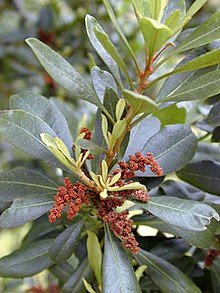

This article needs additional citations for verification. Please help improve this articlebyadding citations to reliable sources. Unsourced material may be challenged and removed.
Find sources: "Myricaceae" – news · newspapers · books · scholar · JSTOR (June 2016) (Learn how and when to remove this message) |
| Myricaceae | |
|---|---|

| |
| Myrica faya | |
| Scientific classification | |
| Kingdom: | Plantae |
| Clade: | Tracheophytes |
| Clade: | Angiosperms |
| Clade: | Eudicots |
| Clade: | Rosids |
| Order: | Fagales |
| Family: | Myricaceae A.Rich.exKunth[1] |
| Type genus | |
| Myrica L. 1753 | |
| Genera | |
|
Canacomyrica Guillaumin | |

| |
| The range of Myricaceae. | |
Myricaceae is a small family of dicotyledonous shrubs and small trees in the order Fagales with its type genus Myrica, the sweet gales. There are three genera in the family, although some botanists separate many species from Myrica into a fourth genus Morella. About 55 species are usually accepted in Myrica (with Morella included), one in Canacomyrica, and one in Comptonia.[2]
Well-known members of this family include bayberry and sweetfern.
Modern molecular phylogenetics suggest the following relationships:[3]
| |||||||
| Myricaceae |
|
|---|---|
| Authority control databases: National |
|
|---|
This Fagales article is a stub. You can help Wikipedia by expanding it. |